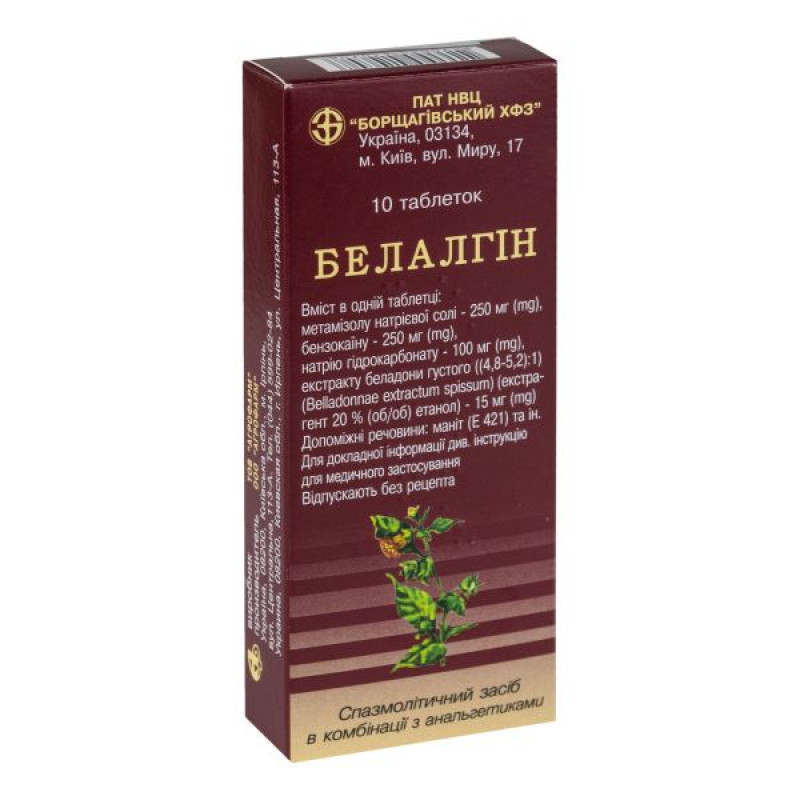Belalgin tablets blister No. 10

Instructions Belalgin tablets blister No. 10
Composition
active ingredients: 1 tablet contains metamizole sodium salt in terms of anhydrous substance - 250 mg, benzocaine - 250 mg, sodium bicarbonate - 100 mg, thick belladonna extract ((4.8-5.2):1) (Belladonnae extractum spissum) (extractant 20% (v/v ethanol)) - 15 mg;
Excipients: microcrystalline cellulose, mannitol (E421), croscarmellose sodium, magnesium stearate, colloidal anhydrous silicon dioxide.
Dosage form
Pills.
Main physicochemical properties: round tablets, with a flat surface, from light brown to brownish-yellow in color with inclusions, with beveled edges (chamfer) and a score.
Pharmacotherapeutic group
Drugs used in functional gastrointestinal disorders. Antispasmodics in combination with analgesics. Sum of belladonna alkaloids in combination with analgesics. ATX code A03D B.
Pharmacological properties
Due to the M-cholinolytic action of belladonna extract, the drug reduces the tone and motor activity of the smooth muscles of the gastrointestinal tract and other organs, reduces the secretion of exocrine glands. The analgesic effect of the drug is due to the effects of metamizole sodium and local anesthetic - benzocaine. Sodium bicarbonate neutralizes free hydrochloric acid in the stomach.
Indication
Functional disorders of the gastrointestinal tract (abdominal pain of functional origin).
Gallstone disease.
Contraindication
Hypersensitivity to belladonna, benzocaine, other amide anesthetics, metamizole sodium and other pyrazolone derivatives, or to any component of the drug.
Cardiovascular diseases in which an increase in heart rate may be undesirable: atrial fibrillation, tachycardia, chronic heart failure, ischemic heart disease, mitral stenosis, severe arterial hypertension.
Glaucoma.
Urinary retention or tendency to it, including prostate adenoma with impaired urine outflow.
Myasthenia gravis.
Gastrointestinal tract diseases accompanied by obstruction.
Hyperthermic syndrome.
Thyrotoxicosis.
Acute bleeding.
Changes in the composition of peripheral blood: agranulocytosis, leukopenia.
Blood diseases: anemia of any etiology, cytostatic or infectious neutropenia.
Marked changes in liver and/or kidney function (porphyrin metabolism).
Congenital deficiency of glucose-6-phosphate dehydrogenase.
Bronchial asthma.
Suspicion of acute surgical pathology.
Interaction with other medicinal products and other types of interactions
If the patient is taking any other medications, it is imperative to inform the doctor.
Interactions that may be caused by metamizole sodium
X-ray contrast agents, colloidal blood substitutes, penicillin - should not be used during treatment with metamizole sodium.
Chlorpromazine or other phenothiazine derivatives - possible development of severe hypothermia.
Oral hypoglycemic drugs (including sulfonylurea derivatives), indirect anticoagulants, glucocorticosteroids, indomethacin - metamizole sodium increases the activity of these drugs by displacing them from protein binding.
Phenylbutazone, glutethimide, barbiturates and other inducers of liver microsomal enzymes - the effectiveness of metamizole sodium is reduced.
Non-narcotic analgesics, tricyclic antidepressants, hormonal contraceptives and allopurinol - possible increase in the toxicity of metamizole sodium.
Nonsteroidal anti-inflammatory drugs - their analgesic and antipyretic effects are potentiated and the likelihood of additive undesirable side effects increases.
Sedatives and tranquilizers (sibazon, trioxazine, valocordin), codeine, anaprilin, histamine H2 receptor blockers, propranolol - enhance the analgesic effect of metamizole sodium.
Sarcolysin, mercazolil, thiamazole, drugs that suppress bone marrow activity, including gold preparations - the likelihood of hematotoxicity, including the development of leukopenia, increases.
Cyclosporine - the concentration of cyclosporine in the blood plasma decreases.
Diuretics (furosemide) - possible reduction in diuretic effect.
Methotrexate - metamizole in high doses can lead to an increase in the concentration of methotrexate in the blood plasma and an increase in its toxic effects (on the digestive system and the hematopoietic system).
Metamizole sodium enhances the sedative effect of ethanol.
Metamizole can induce metabolic enzymes, including CYP2B6 and CYP3A4.
Concomitant use of metamizole with bupropion, efavirenz, methadone, valproate, cyclosporine, tacrolimus and sertraline may result in decreased plasma concentrations of these drugs with potential for reduced clinical efficacy. Therefore, caution is recommended when using metamizole concomitantly; monitoring of clinical response to treatment and/or drug levels may be necessary.
Interactions that may be caused by belladonna extract and benzocaine
Antiparkinsonian drugs (amantadine), M-cholinoblockers, antiarrhythmic anticholinergic drugs (including quinidine, disopyramide), antispasmodics, tricyclic antidepressants, glutethimide - the anticholinergic effects of Belalgin are enhanced.
Opioid analgesics and drugs that depress the central nervous system (including phenothiazines) - dangerous inhibition of the central nervous system occurs, a possible decrease in the duration and depth of the effect of narcotic drugs, and a weakening of the analgesic effect of opiates.
Butyrophenones (haloperidol), organic nitrates – increase intraocular pressure.
Corticosteroids for systemic use – the effect of corticosteroids is reduced and an increase in intraocular pressure is possible.
Pilocarpine - its effect in the treatment of glaucoma is reduced.
Furosemide – possible orthostatic hypotension.
Reserpine, guanethidine, antacids, ascorbic acid, attapulgite - the effect of Belalgin is reduced.
Levodopa - systemic concentrations of levodopa are reduced, so its dosage should be adjusted.
Some antihistamines (including meclizine) - the antihistamine effect is enhanced.
Beta-adrenergic blockers – their effect is reduced.
Hormonal contraceptives – the contraceptive effect is reduced.
MAO inhibitors, including non-selective monoamine reuptake inhibitors – increase the sedative effect and may cause cardiac arrhythmias.
Nonsteroidal anti-inflammatory drugs, griseofulvin, digitoxin, doxycycline, metoclopramide, metronidazole - the effect of these drugs is reduced.
Ketoconazole - increasing the pH of gastric juice with Belalgin reduces the absorption of ketoconazole, so Belalgin should be taken no earlier than 2 hours after taking ketoconazole.
Sulfonamides - their antibacterial activity is reduced.
Indapamide, nizatidine - their effect is increased.
Potassium chloride - possible damage to the mucous membrane of the gastrointestinal tract.
Inhibition of peristalsis by the drug may lead to changes in the absorption of other drugs.
Diphenhydramine, diprazine – the effect of Belalgin is enhanced.
Spironolactone, minoxidil – reduction of their effect.
Penicillins – the effect of both drugs is enhanced.
Application features
Before starting treatment with Belalgin, you should consult a doctor.
Drug-induced liver injury
Cases of acute hepatitis, mainly hepatocellular in nature, have been reported in patients receiving metamizole, occurring within a few days to several months after the start of treatment. Symptoms included elevations in serum liver enzymes with or without jaundice, often in combination with other hypersensitivity reactions (e.g. skin rash, blood disorders, fever, eosinophilia) or with signs of autoimmune hepatitis. Most patients recovered after discontinuation of metamizole; however, in isolated cases, progression to acute liver failure requiring liver transplantation has been reported. The mechanism of liver damage caused by metamizole is not clearly understood, but evidence suggests an immunoallergic mechanism. Patients should be informed of the need to seek medical attention if symptoms suggestive of liver damage occur. In these cases, metamizole should be discontinued and liver function should be assessed. Metamizole should not be re-administered to patients with an episode of liver injury during metamizole treatment for whom no other cause of liver injury has been identified.
Severe skin reactions
Severe skin reactions, including Stevens-Johnson syndrome, toxic epidermal necrolysis and drug reaction with eosinophilia and systemic symptoms (DRESS syndrome), which can be life-threatening or fatal, have been reported with metamizole treatment.
Patients should be informed about the symptoms of skin reactions and the need to monitor them closely.
If signs and symptoms suggestive of these reactions appear, metamizole treatment should be discontinued and under no circumstances restarted (see section "Contraindications").
In case of persistent or worsening pain of unexplained origin in the abdominal area, accompanied by symptoms such as fever, nausea, vomiting, changes in bowel movements, decreased blood pressure, fainting, or blood in the stool, a doctor's consultation is necessary.
Do not exceed the recommended dosage. Use the smallest amount of the drug necessary.
Do not use the drug to relieve acute abdominal pain (until the cause is determined).
When using the drug, you should refrain from drinking alcoholic beverages.
It should be used with caution in patients:
with severe arterial hypotension, cardiovascular insufficiency;
with existing allergic diseases (including hay fever) or with a history of such diseases due to an increased risk of developing hypersensitivity reactions;
with prostatic hypertrophy without urinary tract obstruction;
with Down's disease, cerebral palsy, brain damage;
with a history of kidney disease (pyelonephritis, glomerulonephritis), with liver and kidney failure;
with inflammatory bowel diseases, including ulcerative colitis and Crohn's disease;
with megacolon;
with xerostomia (dry mouth);
elderly age - may lead to an increased frequency of adverse reactions, especially from the digestive tract;
with chronic lung diseases accompanied by low sputum production that is difficult to separate, especially in weakened patients;
with chronic lung diseases without reversible obstruction;
with autonomic neuropathy;
during treatment with cytostatics;
with chronic alcoholism;
with hyperthermia, especially in elderly and weakened patients - hyperthermia may increase;
at high ambient temperature (risk of heat stroke due to suppression of sweat gland activity).
In patients with undiagnosed and therefore untreated angle-closure glaucoma, anticholinergics such as belladonna may increase intraocular pressure. Therefore, if pain, redness of the eyes, accompanied by deterioration/loss of vision, occurs, the patient should consult an ophthalmologist.
There is a risk of developing methemoglobinemia when using drugs containing benzocaine, mainly in patients with congenital defects such as, for example, glucose-6-phosphate dehydrogenase deficiency, NADH-methemoglobin reductase deficiency, pyruvate kinase deficiency, hemoglobinosis M. Symptoms such as cyanosis of the skin, lips and nail beds, headache, dizziness, difficulty breathing, weakness, tachycardia may indicate methemoglobinemia, which is potentially life-threatening and requires urgent medical intervention.
Belladonna alkaloids may affect the results of the following laboratory tests:
stomach acidity test (may counteract the activity of pentagastrin and histamine; the drug should be stopped 24 hours before the test);
radioisotope study of gastric emptying (may slow gastric emptying);
phenolsulfophthalein urine secretion test (may slow down the excretion of phenolsulfophthalein in the urine).
The drug contains benzocaine, which may cause a positive doping test result in athletes.
Regular long-term use of the drug is not recommended due to the myelotoxicity of metamizole; with prolonged use (more than 7 days), it is necessary to monitor the qualitative and quantitative composition of peripheral blood, especially the leukocyte formula.
When using the drug, the development of agranulocytosis is possible, therefore, if an unmotivated increase in temperature, chills, sore throat, difficulty swallowing, stomatitis, bleeding gums, pallor of the skin, asthenia, as well as inflammation of the external genital organs and anus are detected, the drug should be immediately discontinued.
The use of the drug should be discontinued if rashes appear on the skin and mucous membranes. If these symptoms appear, you should immediately consult a doctor.
When taking the drug, urine may turn red due to the excretion of the metabolite of metamizole sodium, which has no clinical significance.
The drug should not be used for longer than the prescribed period without consulting a doctor.
If the signs of the disease do not disappear or, on the contrary, the state of health worsens, or undesirable phenomena appear, it is necessary to stop taking the drug and consult a doctor regarding further use.
Use during pregnancy or breastfeeding
The drug is contraindicated during pregnancy.
If necessary, use of the drug should be discontinued.
Ability to influence reaction speed when driving vehicles or other mechanisms
It is not recommended to use the drug for patients whose activities require concentration of attention and speed of psychomotor reactions.
Method of administration and doses
Belalgin is intended for symptomatic short-term use, therefore the dose and duration of treatment should be selected individually.
Adults should take 1 tablet orally for pain (if necessary). Maximum daily dose is 10 tablets.
Children.
There is no clinical data on the efficacy and safety of use in children, therefore the drug should not be used in patients under 18 years of age.
Overdose
Belladonna extract.
Symptoms: increased manifestations of adverse reactions, nausea, vomiting, tachycardia, decreased blood pressure, impaired accommodation, psychomotor agitation, irritability, tremor, convulsions, insomnia, drowsiness, hallucinations, delirium, hyperthermia, depression of the central nervous system, depression of the activity of the respiratory and vasomotor centers, urinary retention.
Metamizole sodium.
Symptoms: hypothermia, pronounced decrease in blood pressure, palpitations, shortness of breath, dysphagia, tinnitus, nausea, vomiting, stomach pain, oliguria, anuria, tachycardia, weakness, drowsiness, delirium, impaired consciousness, convulsive syndrome; possible development of acute agranulocytosis, hemorrhagic syndrome, acute renal and hepatic failure, paralysis of the respiratory muscles.
Symptoms: drowsiness, anxiety, agitation, in severe cases - convulsions due to its systemic absorption. There are reports that the appointment of drugs containing benzocaine can cause methemoglobinemia. Symptoms such as cyanosis of the skin, lips and nail beds, headache, dizziness, shortness of breath, weakness, tachycardia may indicate methemoglobinemia, which is potentially life-threatening and requires urgent medical intervention.
Treatment: gastric lavage, administration of saline laxatives, activated charcoal. Forced diuresis, hemodialysis, blood alkalization, symptomatic therapy aimed at supporting vital functions. In case of convulsive syndrome, intravenous administration of diazepam and fast-acting barbiturates, parenteral administration of cholinomimetics and anticholinesterase agents should be carried out. In case of hyperthermia, wet wipes and antipyretics are indicated; in case of excitement, intravenous administration of thiopental sodium or sodium oxybutyrate; in case of mydriasis, topically, in the form of eye drops, phosphacol, physostigmine, pilocarpine. In case of an attack of glaucoma, 2 drops of 1% pilocarpine solution should be immediately instilled into the conjunctival sac every hour and 1 ml of 0.05% proserin solution should be administered subcutaneously 3-4 times a day. Do not use phenothiazines. In case of methemoglobinemia, intravenous administration of methylene blue is indicated. Treatment is symptomatic.
At the first symptoms of overdose, you should seek medical attention immediately.
Side effects
Belladonna extract.
Nervous system: headache, dizziness.
Urinary system: difficulty and delay in urination.
Digestive system: dryness in the mouth, thirst, taste disturbance, dysphagia, decreased intestinal motility up to atony, decreased tone of the biliary tract and bile mixture.
Organs of vision: pupil dilation, photophobia, accommodation paralysis, blurred vision, increased intraocular pressure, temporary visual disturbances.
Cardiovascular system: facial flushing, hot flashes, palpitations, arrhythmias (including extrasystole), myocardial ischemia.
Respiratory system and mediastinal organs: decreased secretory activity and bronchial tone, leading to the formation of viscous sputum that is difficult to cough up.
Immune system: possible manifestations of hypersensitivity reactions, including anaphylactic reactions, anaphylactic shock.
Skin and subcutaneous tissue: skin rash, itching, urticaria, exfoliative dermatitis, hyperemia.
Other: decreased sweating, dry skin and mucous membranes, dysarthria.
Metamizole sodium.
Severe skin reactions, including Stevens-Johnson syndrome, toxic epidermal necrolysis and drug reaction with eosinophilia and systemic symptoms (DRESS), have been reported with the use of metamizole (see section "Special warnings and precautions for use").
Blood and lymphatic system: with prolonged use, agranulocytosis, leukopenia, thrombocytopenia, anemia, granulocytopenia are possible.
Urinary system: usually in patients with impaired renal function and/or when using excessive doses, transient oliguria, anuria, proteinuria, toxic nephropathy in various forms, including interstitial nephritis, develops. Red coloration of urine is possible.
Immune system, skin and subcutaneous tissue: possible manifestations of hypersensitivity reactions, including skin and mucous membrane rashes, conjunctivitis, itching, urticaria, angioedema, including Quincke's edema, bronchospastic syndrome, anaphylactic shock, Stevens-Johnson syndrome, Lyell's syndrome, drug reaction with eosinophilia and systemic symptoms (DRESS).
Nervous system: nervousness, insomnia, psychomotor agitation, convulsions.
Cardiovascular system: tachycardia, decreased blood pressure.
Digestive tract: constipation, diarrhea.
Hepatobiliary system: drug-induced liver injury, including acute hepatitis, jaundice, increased liver enzymes (see section "Special warnings and precautions for use").
When using the drug, methemoglobinemia (cyanosis of the skin, lips and nail beds, headache, dizziness, shortness of breath, weakness, tachycardia) is possible (the drug contains benzocaine).
If any adverse reactions occur, you should stop taking the drug and be sure to consult a doctor.
Expiration date
3 years.
Do not use the drug after the expiration date indicated on the package.
Storage conditions
In the original packaging at a temperature not exceeding 25 °C.
Keep out of reach of children.
Packaging
10 tablets in a blister, 1 blister in a pack.
Vacation category
Without a prescription.
Producer
Public Joint Stock Company "Research and Production Center "Borshchagov Chemical and Pharmaceutical Plant".
Limited Liability Company "Agropharm".
Address
Ukraine, 03134, Kyiv, Myru St., 17.
Ukraine, 08200, Kyiv region, Irpin city, Centralna st., 113-A.
There are no reviews for this product.
There are no reviews for this product, be the first to leave your review.
No questions about this product, be the first and ask your question.












